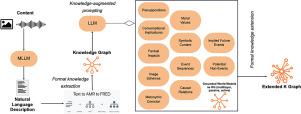基于世界模型的神经符号图富集
IF 6.9
1区 管理学
Q1 COMPUTER SCIENCE, INFORMATION SYSTEMS
引用次数: 0
摘要
开发能够理解和推理复杂现实世界场景的人工智能系统是一项重大挑战。在这项工作中,我们提出了一种新颖的方法来增强和利用 LLM 的反应能力,以解决复杂问题和解释深层语境的现实世界含义。我们介绍了一种方法和工具,用于创建多模态、知识增强的正式意义表征,该表征结合了大型语言模型和结构化语义表征的优势。我们的方法从图像输入开始,利用最先进的大型语言模型生成自然语言描述。然后,这种描述会被转化为意义表示(AMR)图,并通过逻辑设计模式以及从语言和事实知识库中提取的分层语义对其进行形式化和丰富。由此产生的图谱随后被反馈到 LLM 中,通过复杂的启发式学习(包括语义暗示、道德价值观、具身认知和隐喻表征)激活的隐含知识对其进行扩展。通过弥合非结构化语言模型和正式语义结构之间的差距,我们的方法为解决自然语言理解和推理中的复杂问题开辟了新的途径。本文章由计算机程序翻译,如有差异,请以英文原文为准。

Neurosymbolic graph enrichment for Grounded World Models
The development of artificial intelligence systems capable of understanding and reasoning about complex real-world scenarios is a significant challenge. In this work we present a novel approach to enhance and exploit LLM reactive capability to address complex problems and interpret deeply contextual real-world meaning. We introduce a method and a tool for creating a multimodal, knowledge-augmented formal representation of meaning that combines the strengths of large language models with structured semantic representations. Our method begins with an image input, utilizing state-of-the-art large language models to generate a natural language description. This description is then transformed into an Meaning Representation (AMR) graph, which is formalized and enriched with logical design patterns, and layered semantics derived from linguistic and factual knowledge bases. The resulting graph is then fed back into the LLM to be extended with implicit knowledge activated by complex heuristic learning, including semantic implicatures, moral values, embodied cognition, and metaphorical representations. By bridging the gap between unstructured language models and formal semantic structures, our method opens new avenues for tackling intricate problems in natural language understanding and reasoning.
求助全文
通过发布文献求助,成功后即可免费获取论文全文。
去求助
来源期刊

Information Processing & Management
工程技术-计算机:信息系统
CiteScore
17.00
自引率
11.60%
发文量
276
审稿时长
39 days
期刊介绍:
Information Processing and Management is dedicated to publishing cutting-edge original research at the convergence of computing and information science. Our scope encompasses theory, methods, and applications across various domains, including advertising, business, health, information science, information technology marketing, and social computing.
We aim to cater to the interests of both primary researchers and practitioners by offering an effective platform for the timely dissemination of advanced and topical issues in this interdisciplinary field. The journal places particular emphasis on original research articles, research survey articles, research method articles, and articles addressing critical applications of research. Join us in advancing knowledge and innovation at the intersection of computing and information science.
 求助内容:
求助内容: 应助结果提醒方式:
应助结果提醒方式:


